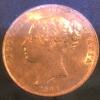I reckon so. It is the only way you can reconcile a third head (where the earliest known use is 1880) proof sixpence obverse paired with an 1839 reverse. The mint shut for refurbishment in 1882 when the old Soho presses were replaced, making this a possible terminal date for the sets, unless the die fixing mechanisms were compatible. I suspect they ran off a handful to order in this late period, the number of said sixpences extant giving a rough estimate of total sets produced. There was one in a Heritage or Goldberg(?) sale a few years back, but the sale date eludes me at present, so I would have to check the library. I vaguely recall it had the opposite die axis to the sets with the regular obverse sixpence, which leads me to think that the 1839/41 halfpenny in my possession may well be concurrent with this oddball sixpence as it also has an inverted die axis and is correspondingly rare, contrary to the regular 1839 or 1839/43 halfpennies.
There is an 1839 proof groat with an inverted die axis, noted in ESC as being rarer than the regular en-medaille proof. Is this a third instance of a late strike? If so, the scored reverse would tie in well with the article I wrote in the BNJ about the inverted die axis 1841 halfpennies, where they had used the same worn reverse die. The condition didn't matter as the obverse was the die of interest. By extension, it is also possible there are trials extant of all the denominations if there had been a long period without any 1839 sets produced.
 Coinpublications.com
Coinpublications.com



